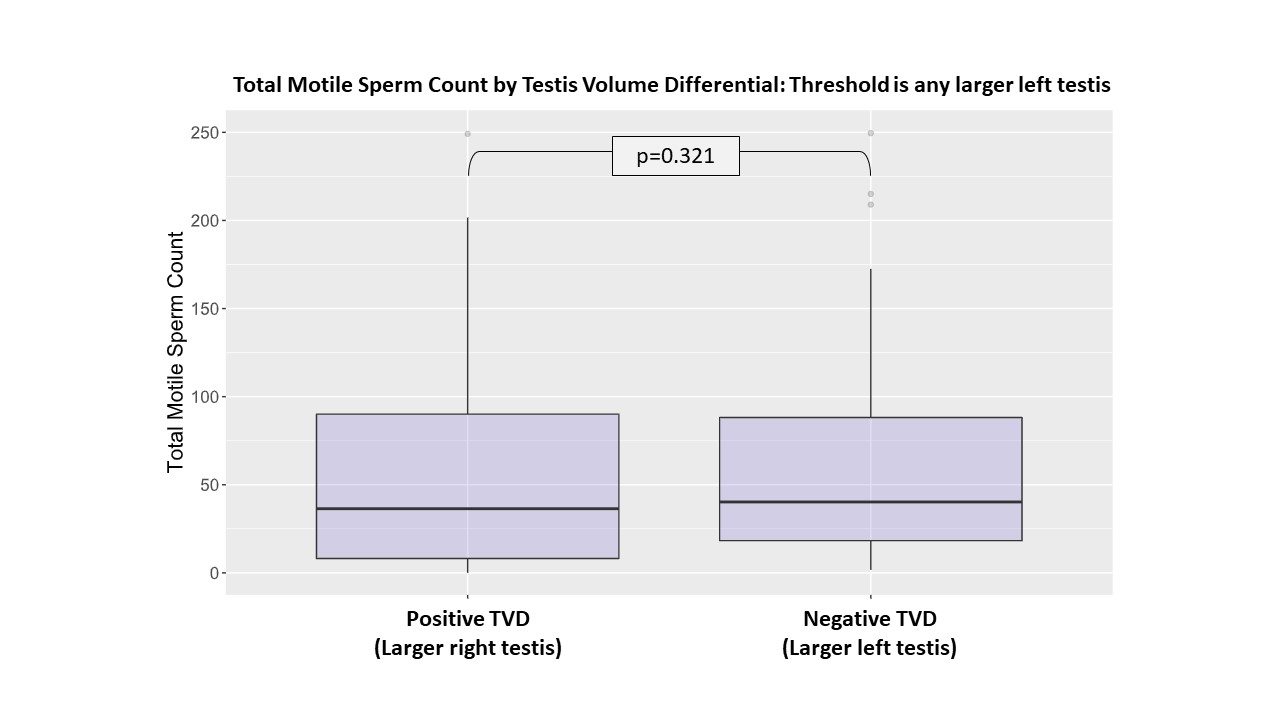An Asymmetrically Larger Left Testis in Adolescent Varicocele - Favorable Sign for Fertility Potential?
Eric Bortnick, MD, Caleb P. Nelson, MD, MPH, Badar Omar, BA, Michael P. Kurtz, MD, MPH.
Boston Children's Hospital, Boston, MA, USA.
BACKGROUND: A smaller left testis has long been considered an unfavorable finding in the setting of adolescent varicocele due to concerns that it may be a sign of local factors inhibiting ipsilateral testicular development. While surprising and counteractive, the opposite is occasionally seen: boys present with a left varicocele, and with a left testis which is larger than the right. The impact and clinical significance of a larger left testis in adolescent varicocele has not been determined. We hypothesized that there would be no difference in fertility potential associated with a larger left testis at presentation , compared with those boys with a left testis which is either smaller or closer to symmetry.
METHODS: We analyzed a prospectively-assembled database of boys presenting with varicocele to a single institution. We included boys with ultrasound-based measures of testis volume, at least one semen analysis, and no history of varicocele surgery. We calculated testis volume differential (TVD) and total motile sperm count (TMSC). We used the threshold of favorable spontaneous fertility of TMSC above 20 million, and examined cutoffs of negative TVD (larger left testis) of <0%, <10%, and <20%. Continuous variables were analyzed with a Wilcoxon test, discrete outcomes with Fisher’s exact test, and logistic regression for multivariate analysis (R version 4.3.0).
RESULTS: 103 boys met inclusion criteria; 35 had a negative TVD (larger left testis). Other than in measures of left testis volume, the groups were comparable (Table 1). There was no difference in TMSC comparing boys with positive and negative TVD (median 40.2 [18.3,88.1] vs median 36.4 [8.2,90], p=.32) (Figure 1). At no threshold of negative TVD, i.e. the degree to which the left testis is larger than the right (TVD <0%, p=0.64; TVD<10%, p=1; TVD<20 %, p=0.48), did we observe a relationship between a larger left testis and a higher probability of a normal TMSC . As total testis volume (TTV) is known to be associated with favorable TMSC (p=0.038), we included it in a multivariate analysis; negative TVD remained not significant (OR 1.3, 95%CI 0.55-3.2, p=0.55).
CONCLUSIONS: A larger left testis at presentation with adolescent varicocele appears to confer no protective effect with respect to fertile semen parameters.
| Overall Cohort n=103 | TVD<0, n=35 (larger left testis) | TVD>0, n=68 (larger right testis) | ||
| Age at Presentation, years Median [IQR} | 16.3 [14.2,17.5] | 16.6 [14.2,17.5] | 16.2 [14.2,17.4] | p=0.64 |
| Age at Representative Semen Analysis, years, Median [IQR] | 17.4 [16.2,18.4] | 17.7 [17.0,18.8] | 17.3 [16.0,18.3] | p=0.39 |
| Varicocele Grade | p=0.29 | |||
| Grade 1 | 9 (8.7%) | 6 (17.1%) | 3 (4.4%) | |
| Grade 2 | 38 (36.9%) | 8 (22.9%) | 30 (44.1%) | |
| Grade 3 | 45 (43.7%) | 18 (51.4%) | 27 (39.7%) | |
| Not known | 11 (10.7%) | 3 (8.5%) | 8 (11.7%) | |
| Right Testis Volume, mL Median [IQR] | 16.9 [11.9,20.6] | 14.6 [11.6,18.5] | 17.9 [12.6,22.2] | p=0.08 |
| Left Testis Volume, mL Median [IQR] | 15.1 [10.8,17.6] | 16.9 [14.0,19.8] | 14.0 [9.4,16.6] | p=0.009 |
| Total Testis Volume, mL Median [IQR] | 32.0 [22.5,38.1] | 31.4 [25.1,39.0] | 33.2 [31.4,37.6] | p=0.88 |
| Testis Volume Differential, TVD, mL Median [IQR] | 11.5 [-3.9, 23.5] | -9.0 [-17.9, -4.0] | 20.2 [12.3, 26.5] | p<0.001 |
| Total Motile Sperm Count, Million, Median [IQR] | 38.9 [13.2,92.1] | 40.2 [18.3,88.1] | 36.4 [8.2,90] | p=0.32 |
| Total Motile Sperm Count > 20M | 63 (61.2%) | 23 (65.7%) | 40 (58.8%) | p=0.53 |

Back to 2023 Abstracts
